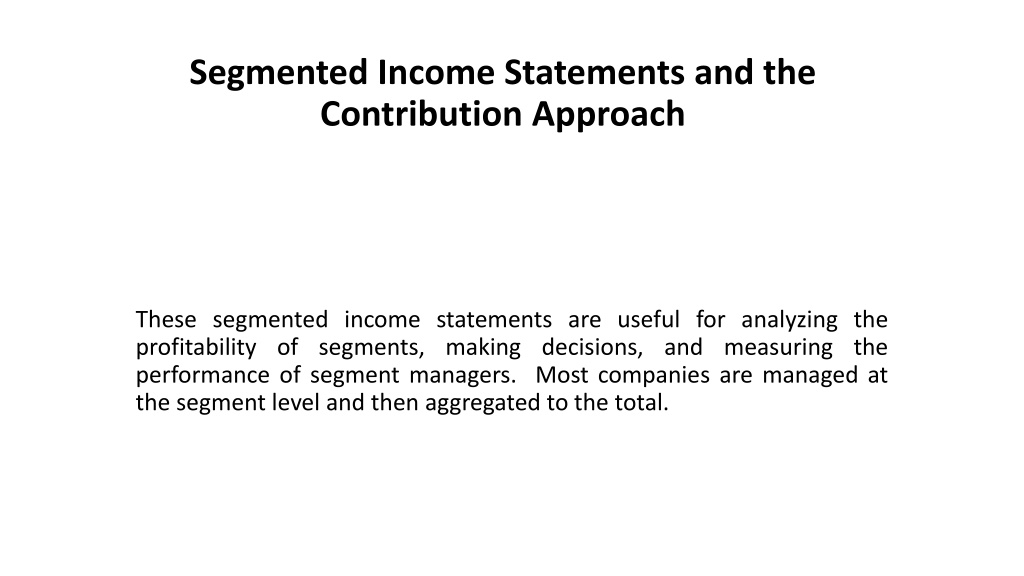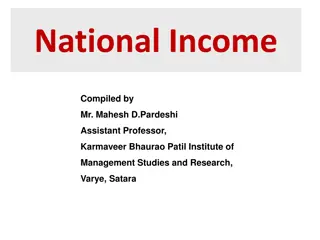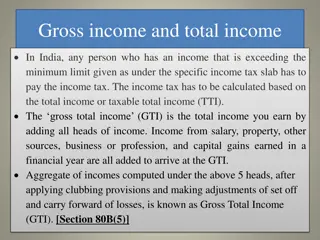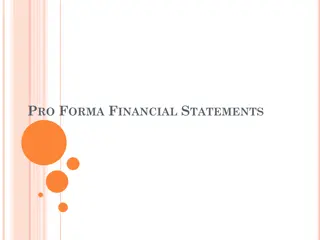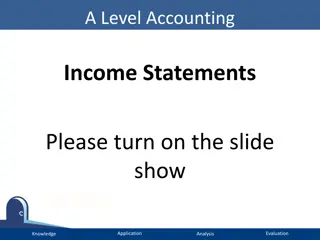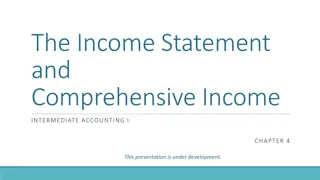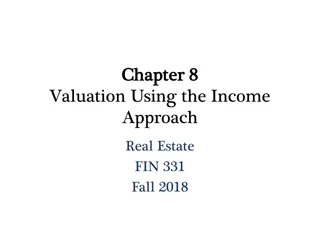Understanding Segmented Income Statements and the Contribution Approach
Segmented income statements help analyze segment profitability, make decisions, and measure segment manager performance. This approach involves traceable fixed costs, common fixed costs, and segment margins. Segment margin represents profitability after covering all costs associated with the segment, providing insights for long-term decisions and pricing strategies. Identifying traceable fixed costs is crucial for accurate segment reporting.
Download Presentation

Please find below an Image/Link to download the presentation.
The content on the website is provided AS IS for your information and personal use only. It may not be sold, licensed, or shared on other websites without obtaining consent from the author. Download presentation by click this link. If you encounter any issues during the download, it is possible that the publisher has removed the file from their server.
E N D
Presentation Transcript
Segmented Income Statements and the Contribution Approach These segmented income statements are useful for analyzing the profitability of segments, making decisions, and measuring the performance of segment managers. Most companies are managed at the segment level and then aggregated to the total.
Traceable and Common Fixed Costs and the Segment Margin Three new terms are needed to prepare segmented income statements using the contribution approach traceable fixed cost,common fixed cost, and segment margin. A common fixed cost (indirect cost) is a fixed cost that supports the operations of more than one segment, but is not traceable in whole or in part to any one segment. Even if a segment were entirely eliminated, there would be no change in a true common fixed cost. For example: A traceable fixed cost (direct cost) of a segment is a fixed cost that is incurred because of the existence of the segment if the segment had never existed, the fixed cost would not have been incurred; and if the segment were eliminated, the fixed cost would disappear. The salary of the CEO of General Motors is a common fixed cost of the various divisions of General Motors. The salary of the Fritos product manager at PepsiCo is a traceable fixed cost of the Fritos business segment of PepsiCo. The cost of heating a Safeway or Kroger grocery store is a common fixed cost of the store s various departments groceries, produce, bakery, meat, and so forth. The maintenance cost for the building in which Boeing 747s are assembled is a traceable fixed cost of the 747 business segment of Boeing.
The Segment Margin. To prepare a segmented income statement, variable expenses are deducted from sales to yield the contribution margin for the segment. The segment margin is obtained by deducting the traceable fixed costs of a segment from the segment s contribution margin.
The segment margin represents the margin available after a segment has covered all of its own costs. The segment margin is the best gauge of the long-run profitability of a segment because it includes only those costs that are caused by the segment. If a segment can t cover its own costs, then that segment probably should be dropped (unless it has important side effects on other segments). Notice, common fixed costs are not allocated to segments. By contrast, the contribution margin is most useful in decisions involving short-run changes in volume, such as pricing special orders that involve temporary use of existing capacity.
Identifying Traceable Fixed Costs The distinction between traceable and common fixed costs is crucial in segment reporting because traceable fixed costs are charged to segments and common fixed costs are not. In an actual situation, it is sometimes hard to determine whether a cost should be classified as traceable or common. The general guideline is to treat as traceable costs only those costs that would disappear over time if the segment itself disappeared. For example, if one division within a company were sold or discontinued, it would no longer be necessary to pay that division manager s salary. Therefore, the division manager s salary would be classified as a traceable fixed cost of the division. On the other hand, the president of the company undoubtedly would continue to be paid even if one of many divisions was dropped. When assigning costs to segments, the key point is to resist the temptation to allocate costs (such as depreciation of corporate facilities) that are clearly common and that will continue regardless of whether the segment exists or not. Any allocation of common costs to segments reduces the value of the segment margin as a measure of long-run segment profitability and segment performance.
Traceable Costs Can Become Common Costs Fixed costs that are traceable to one segment may be a common cost of another segment. For example, United Airlines might want a segmented income statement that shows the segment margin for a particular flight from Chicago to Paris further broken down into first-class, business-class, and economy-class segment margins. The airline must pay a substantial landing fee at Charles DeGaulle airport in Paris. This fixed landing fee is a traceable cost of the flight, but it is a common cost of the first-class, business-class, and economy-class segments. Even if the first-class cabin is empty, the entire landing fee must be paid. The landing fee is not a traceable cost of the first-class cabin. Paying the fee is necessary in order to have any first-class, business-class, or economy-class passengers. The landing fee is a common cost of these three classes.
Segmented Income StatementsDecision Making and Break- Even Analysis Contribution format segmented income statements can be used to make decisions and perform break-even analysis. Let s assume that ProphetMax wants to know the profit impact of discontinuing the sale of computer games through its Retail Stores sales channel. The Online Sales segment has a segment margin of $48,000 The Retail Stores segment has a segment margin of ($3,000) The company believes that online sales of its computer games will increase 10% or $10,000 if it discontinues the Retail Stores sales channel. It also believes that the Business Products Division and Clip Art product line will be unaffected by this decision. How would you compute the profit impact of this decision?
Segmented Income StatementsDecision Making and Break- Even Analysis The first step is to calculate the profit impact of the Retail Stores sales channel disappearing. If this sales channel disappears, we assume its sales, variable expenses, and traceable fixed expenses would all disappear. The quickest way to summarize these financial impacts is to focus on the Retail Stores segment margin. In other words, if the Retail Stores sales channel disappears, then its negative segment margin of $3,000 would also disappear. This would increase ProphetMax s net operating income by $3,000. The second step is to calculate the profit impact of increasing online sales of computer games by 10%. To perform this calculation, the Online Sales has a contribution margin ratio constant of 63% If online sales increase $10,000, then the Online Sales segment s contribution margin will increase by $6,300 ($10,000 63%). The overall profit impact of discontinuing the Retail Stores sales channel can be summarized as follows:
Break-Even Analysis Compute companywide and segment break- even points for a company with traceable fixed costs. We should begin by reviewing the information in the Total Company column. Total traceable fixed expenses are $171,000 and its total common fixed expenses are $85,500. Furthermore, the company s overall contribution margin is 54% Given this information, ProphetMax s companywide break-even point is computed as follows: It is important to emphasize that this computation assumes a constant sales mix. In other words, in the ProphetMax example, it assumes that 60% of the total sales will come from the Business Products Division and 40% of the total sales will always from the Consumer Products Division.
Break-Even Analysis Compute companywide and segment break- even points for a company with traceable fixed costs. We should begin by reviewing the information in the Total Company column. Total traceable fixed expenses are $171,000 and its total common fixed expenses are $85,500. Furthermore, the company s overall contribution margin is 54% Given this information, ProphetMax s companywide break-even point is computed as follows: It is important to emphasize that this computation assumes a constant sales mix. In other words, in the ProphetMax example, it assumes that 60% of the total sales will come from the Business Products Division and 40% of the total sales will always from the Consumer Products Division.
Break-Even Analysis Compute companywide and segment break- even points for a company with traceable fixed costs. To compute the break-even point for a business segment, the formula is as follows: In the case of ProphetMax s Business Products Division, the Business Products Division s traceable fixed expenses are $90,000 and its CM ratio is 50%. The calculation for the Consumer Products Division
Notice that the sum of the segment break-even sales figures of $315,000 ($180,000 + $135,000) is less than the companywide break-even point of $475,000. When each segment achieves its break-even point, the company s overall net operating loss of $85,500 equals its common fixed expenses of $85,500. This reality can often lead managers astray when making decisions. In an attempt to cover the company s common fixed expenses, managers will often allocate common fixed expenses to business segments when performing break-even calculations and making decisions. This is a mistake! This occurs because the segment break-even calculations do not include the company s common fixed expenses. The exclusion of the company s common fixed expenses can be verified by preparing income statements based on each segment s break-even dollar sales as follows Allocating common fixed expenses to business segments artificially inflates each segment s break-even point. This may cause managers to erroneously discontinue business segments where the inflated break-even point appears unobtainable. The decision to retain or discontinue a business segment should be based on the sales and expenses that would disappear if the segment were dropped. Common fixed expenses will persist even if a business segment is dropped, they should not be allocated to business segments when making decisions. It is the responsibility of management to price products sufficientlyhigh to cover all common costs.
Segmented Income StatementsCommon Mistakes All costs attributable to a segment and only those costs should be assigned to the segment. Unfortunately, companies often make mistakes when assigning costs to segments. They omit some costs, use in appropriate methods for assigning traceable costs among segments, and use inappropriate allocation bases. Omission of Costs The costs assigned to a segment should include all costs attributable to that segment from the company s entire value chain. All of these functions, from research and development, through product design, manufacturing, marketing, distribution, and customer service, are required to bring a product or service to the customer and generate revenues. However, only manufacturing costs are included in product costs which is widely regarded as required for external financial reporting. To avoid having to maintain two costing systems and to provide consistency between internal and external reports, many companies also use product costing for their internal reports such as segmented income statements. As a result, such companies omit from their profitability analysis part or all of the upstream costs in the value chain, which consist of research and development and product design, and the downstream costs, which consist of marketing, distribution, and customer service. Yet these nonmanufacturing costs are just as essential in determining product profitability as are the manufacturing costs. These upstream and downstream costs, which are usually included in selling and administrative expenses on absorption costing income statements, can represent half or more of the total costs of an organization. If either the upstream or downstream costs are omitted in profitability analysis, then the product is under-costed and management may unwittingly develop and maintain products that in the long run result in losses.
Segmented Income StatementsCommon Mistakes All costs attributable to a segment and only those costs should be assigned to the segment. Unfortunately, companies often make mistakes when assigning costs to segments. They omit some costs, use in appropriate methods for assigning traceable costs among segments, and use inappropriate allocation bases. Inappropriate Methods for Assigning Traceable Costs among Segments In addition to omitting costs, many companies do not correctly handle traceable fixed expenses on segmented income statements. First, they do not trace fixed expenses to segments even when it is feasible to do so. Second, they use inappropriate allocation bases to allocate traceable fixed expenses to segments. Inappropriate Allocation Base. Some companies use arbitrary allocation bases to allocate costs to segments. For example, some companies allocate selling and administrative expenses on the basis of sales revenues. Thus, if a segment generates 20% of total company sales, it would be allocated 20% of the company s selling and administrative expenses as its fair share. Costs should be allocated to segments for internal decision-making purposes only when the allocation base actually drives the cost being allocated (or is very highly correlated with the real cost driver).
Segmented Income Statements The business staff of the law firm Frampton, Davis & Smythe has constructed the following report that breaks down the firm s overall results for last month into two business segments family law and commercial law: Redo the segment report, eliminating the allocation of common fixed expenses. Would the firm be better off financially if the family law segment were dropped? (Note: Many of the firm s commercial law clients also use the firm for their family law requirements such as drawing up wills.) The firm s advertising agency has proposed an ad campaign targeted at boosting the revenues of the family law segment. The ad campaign would cost $20,000, and the advertising agency claims that it would increase family law revenues by $100,000. The managing partner of Frampton, Davis & Smythe believes this increase in business could be accommodated without any increase in fixed expenses. Estimate the effect this ad campaign would have on the family law segment margin and on the firm s overall net operating income. Compute the companywide break-even point in dollar sales and the dollar sales required for each business segment to break even.
